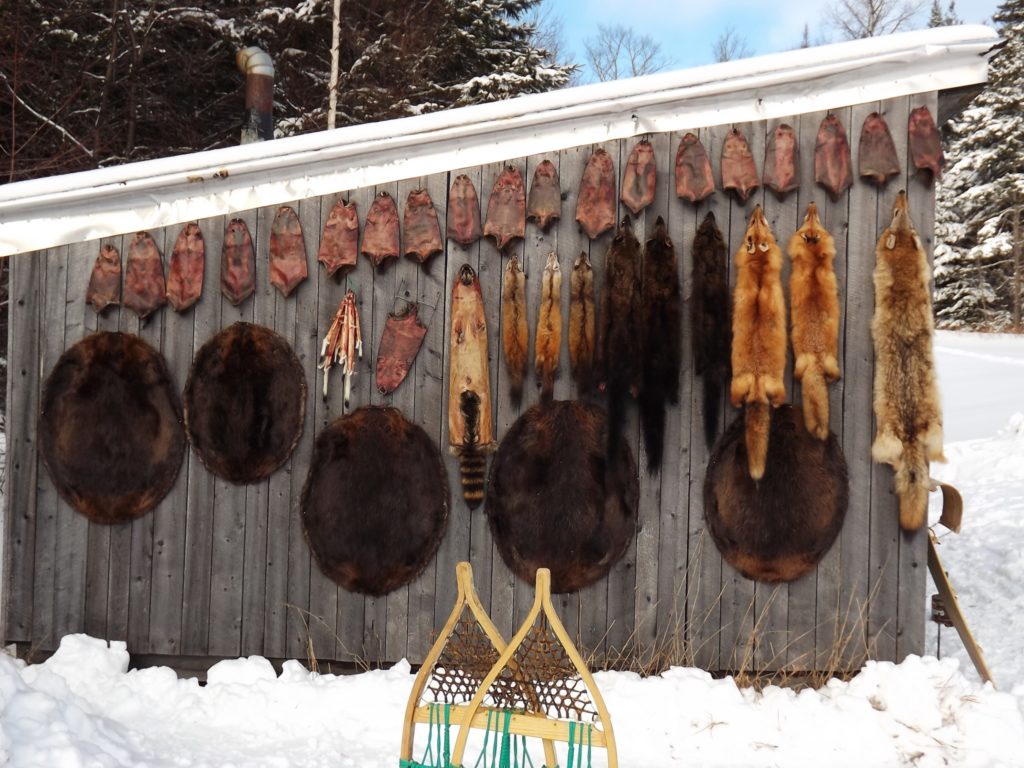IT’S ALL A MATTER OF DEGREES IN THE FUR GAME.
By Cary Rideout
Photo by Loraine Rideout

A good fur catch for a hobby trapper.
We all began trapping as eager tyros with a few sets but once bitten we quickly ran bigger operations each year. Over time our trapping effort ebbed and flowed along with commitments, relationships and jobs. Any line requires work, no small amount of planning and steady checking so if you’re trapping, well you’re trapping, right? Well many times I’ve run into trappers who almost apologized for their efforts. Why? Trapping is one of the few really democratic (and I don’t mean political leanings) pastimes that you can participate in. How you decide to string steel isn’t judged by the trapping community who these days welcomes everyone. Most pastimes now are pretty strict about their members with endless unspoken rules to join but trapping is open to all levels be it ten sets or thousand, the person is a trapper.
Big Country Travelers
Anyone who runs a full on serious trapline covering multiple counties or even states are examples of real determination. Long-line trappers work serious miles hopping all over the map putting down more steel than most of us will ever own. These trappers are driven, quickly adapt no matter the situation and most important of all are located or can travel to the sweet spots of fur trapping gold. Long liners also have that special ability to land on their feet in strange country and lay out a successful line with no prior scouting. How the heck they can is beyond me but they can walk off the road and start a line that will produce fur. These experts seem to have a spooky sixth sense about cold rolling that never misses too much.
I had an afternoon with one of these amazing trappers who did admit sometimes his speculation was a bust but figured he was batting an average in the high 80 percent success range. Most of his trapping was for fox, bobcats and otter which I thought was a weird combo but he had the checks to prove success and said the best fur was just off the hardtop. Asked about numbers, he claimed 300 sets were about right to make serious money but a few more was better. Still able to run 24 hours a day when we talked he said sleep wasn’t all it was cracked up to be! He advised anyone setting their first big line to use simple sets made fast with an eye to using the terrain as much as possible. Make the fur come to you and don’t waste time galloping all over the countryside. Finally, he thought you should build up slowly over a couple seasons to a major campaign so you don’t get in over your head. Not everyone can or would even want to run hundreds of sets and that’s fine.
Long liners can really put out iron fast and more importantly, effectively. Fellows with registered lines often have to trap predetermined numbers of furbearers and these guys push hard to accomplish it. With this kind of work it is full bore and you have to make the fur really fly to get any other trapping done as well. And speaking of single-mindedness, this is another trait the pros seem to share in targeting only one or two furbearers. Most trappers enjoy catching a few of everything each season. I’ve never run a single-species trapline and that is what separates me from the pros I guess. Sure, I trap what might pay a few more dollars but set at least a few traps for all the targets.
Hard-Charging Fur Experts
There was an old time fox pro I used to see at the fur buyer who covered hundreds of miles. He would pull out on opening day with the back seat of his Monarch loaded with steel and, as he said, scatter it like chaff from a combine. He’d sleep out under the stars or in the back seat for over a week sometimes. Fuel was under 40 cents a gallon and good bright reds sure could put some coins in your hands. He mentioned once he used groundhog meat with fox urine in a flat set. When he opened the trunk it seemed to a young guy like me he’d caught every fox in creation! Sadly his kind is mostly gone now but how I’d loved to have tagged along just once to watch him.
Hard-core long-line trappers are so driven I often wonder what sort of successful businessmen they’d make. They don’t mess around or tolerate any sort of obstruction. One told me he had never run up against a problem that didn’t have an answer or solution. Pretty confident talk but pro trappers are in to win and won’t let anything slow them down. They use the most up-to-date tools, their methods are efficient but always open to improvement and they never stop trapping no matter the calendar date. Not to say they work out of season but they are either practicing, gearing up or scouting pretty much all year long. Most hobby or casual trappers can’t spare that amount of time or commitment no matter how much they would like to.
If you ever have the opportunity to run a few days with a pro, do it. They are dynamos of action and like any good craftsman, they have everything at their fingertips. No pointless searching for an hour looking for a missing bolt or bait—everything is always right there. They are out of the vehicle and setting before you can get your safety belt unhooked. Some chase bobcats or coyotes. Others are big number ‘rat men or beaver trappers. They are the trappers who have photos of big strings of fur and very tired faces. Anyone with proof like that has some serious skills and work habits to be envied. A good fox man or big-number otter trapper can almost smell the critters and set exactly right.
Equals On The Trapline
Very few steel stringers today have the time, country or even the stamina to long line. Costs sadly snuff the dreams of big traplines and Old Reality often keeps many of us close to home. But thousands of folks happily work along a creek or two, run a few snares on neighbor’s farm or wrestle the ‘rats in a local slough. They’re still trappers, right?
Some years a trapper has to pull the line early or reduce the steel in the ground for whatever reason and even the numbers guys don’t always run big lines. A few years back I had a rather empty fur parcel to drop off on pick-up day and quietly waited until the crowd thinned before handing in my catch. I spoke in a low voice to the driver almost apologizing for the mostly empty sack explaining about some family commitments that had cut things short. “Hey no problem,” he said. “We are glad to have any fur parcel so hand ‘er up here”. Trapping is sometimes about small numbers but really what’s wrong with that? The industry is keen for pelts and who cares if the numbers come from many hands—it’s all the same. Enjoy the experience and quit worrying about not being like the other fellow.
At one time I worked a series of streams alongside anther trapper. We would run into one another sometimes and he finally admitted to not really doing too much trapping. His entire outfit was comprised of half dozen #220s set for water fur. He seemed uncomfortable to tell me but I appreciated his letting me know. Was he less of trapper? Not one bit!
A few carefully made sets allow the hobby trapper to enjoy the autumn days in a way the hard-driving pro can’t. Not better or worse, just different. With a limited number of sets, the catch can be carefully skinned and boarded. Put some real effort into the processing and make the most of the forest gold you catch. With four or five pelts you can take your time and not work at light speed in the shed. But with dozens or even hundreds of pelts it is about efficient processing with no time for carefree work. The hobby trapper also can match wits with those hard cases that frustrate everyone who traps. You have the time a high mileage line doesn’t allow. Don’t bog down with worrying over how many sets a trapper should have. The enjoyment and satisfaction is the same regardless of the line.
The Happy Hobbyist
The word “amateur” is maybe not the best title since amateur sort of implies a guy who’s all thumbs stumbling around the alders and that’s not true. Maybe “hobbyist” is a better title and to be honest, these days the trapping game is that for more of us than ever before. The part-time trapper is the backbone of the trade and this style of trapping often isn’t quite as small as it sounds. Sure, a dozen sets is pretty easy to handle but it can be a smart operation, too. No matter how much you string, todays’ trappers keep a weather eye on the market watching to see what’s potentially going to pay in the shed. If fox is looking promising, the short-line trapper can easily pinpoint areas of good sign, catch a few and move quickly to another scouted site. Actually, a hobby trapper is often less concerned with prices instead working their line and taking what comes. A few ‘rats and a ‘coon or two are a fine days catch to the short-line trapper.
Many part-time trappers are very well experienced having previously run big lines and are whip sharp operators. There’s a trapper over in the next county who in his words “just potters around” with a few traps but don’t be fooled. He’s got a wall of Top Lot awards and a train car wouldn’t hold the beaver he’s put up. Anyone meeting him on the line would think he was some first timer with a couple #330s he picked up at yard sale. That is until you watch him in action!
Speaking of iron, part-time trappers are supposed to be rusty tool users but we know that’s foolishness. These days we all are aware of regulations and no one, not even the rankest tyro would use a trap the critters might escape from. Quality tools make the operator and no matter if you only have a handful of traps you’ll use the best you are able to buy.
On the money side of things, a hobby trapper can often work for very little cost. A short line is a fine way to keep trapping and smart, too. Why stop? Just down size a bit. Many times, short hobby lines can be hiked. Running a hobby line allows the first-time trapper to get their feet wet and find their rhythm. Some might never have bigger lines, which is fine. That’s the great thing about trapping, there’s no judging so run things the best way for you and it will be fine.
I’ve run lines of many sizes and sometimes the smallest are the ones best remembered. Do I consider myself a hard-charging long liner or an enthusiastic hobby trapper? Actually if you asked I’d probably just reply yes I am trapper. And that should be enough for anybody.
